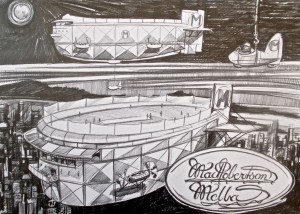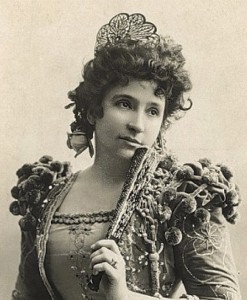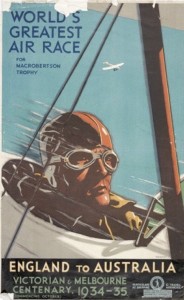The Macpherson Melba, Australias first Dirigible.
In the heady days of the late 20’s nothing seemed beyond the capacity of Australian engineering and technological knowhow. Spurred on by the recent success of Ross and Keith Smith in Southern Cross, and the success of Charles Lindbergh, the great philanthropist Macpherson Macrobertson then a board member of Qantas submitted a proposal for an Australian dirigible adapted from the the famous R101 and Hindenburg, being planned by both Great Britain and Germany respectively..
The specifications called for a lighter than air dirigible, hydrogen filled, with a capacity to carry at least twenty two passengers and some twelve crew in short hops from Melboune, Sydney, Brisbane, Darwin, and thereon to Singapore via Jakarta, Bombay and Calcutta. The design also called for the latest in radio communication, with the capacity to establish constant communication between London and Melbourne as a core criteria.
Faced with the innumerable logistics and challenges of construction, fit-out and gas provision, the established firm of Pustule, Bubo and Wheeze, Abbatoirists and chemical subsidiary of ICI were commissioned to provide gas bags derived from Cow stomach lining. The gas, being derived from the Spotswood pumping station to be piped to a purpose built hangar then under construction at RAAF Point Cook.
Faced with considerable public interest the designers, (Ronaldson Tippett and Co) were encouraged to conduct family field days in which the public for a fee were enthusiastically encouraged to explore the potential of gas powered flight. Before the tour the public were encouraged to savour the newly developed Chiko, cabbage derived rolls. The hangar was modified to contain residual gasses.
By 1930, the first prototype, the ‘Melba’ was ready, and the famous soprano was on hand to launch the mighty craft. Singing, ‘I’m forever blowing bubbles” she suffered a severe stroke upon this occassion tripping over the launching guy which almost resulted in a cataclysmic explosion that was averted by the quick thinking of an attendant who broke the prima donnas fall by throwing himself under the great Soprano. He was posthumously decorated with a Royal Humane Society Medal for Gallantry under pressure.
With the onset of the Great Depression the taste for overseas travel declined. The project appeared doomed until by accident it was discovered during crossing of the Simpson Desert in an electrical storm the large promenade deck acting as a conductor could be utilised for harnessing radio waves. Both as a reflector and receiver. And was sturdy enough to hold at least eleven individuals for a sustained period of time. With this startling information, and the clarity of reception of a broadcast test from Headingly it was then decided to dispense with synthetic cricket, then in vogue, and use the central promenade during thunder storms for actual ‘live’ test cricket.
This revolutionised cricket and radio. Live transmissions could be beamed with perfect clarity to Lords and the MCG and with a special arial gondola suspended below the craft, signals were beamed to anywhere in the Commonwealth. Surprisingly, the power of the transmission was so strong it interrupted transmissions by none other than Alistair Cooke, in his weekly ‘letter from America’ with numerous score updates and detailed descriptions of play. This infuriated American broadcasters and threatened a diplomatic incident not seen since 1812 and threatened to stimulate the imagination of the Americans, not renowned for their cricket enthusiasm or imagination.
All seemed perfectly poised for the first test of the 1930 season, with the Australian test eleven on the field, with attendant umpires, whilst the rest of the English team were held forward for ballast with commentary, umpiring and scoring delivered from the specially constructed forward control deck.
In an exciting encounter all proceeded smoothly until on the Fifth test, whilst returning to Australia via Aden and Bombay the Melba encountered another electrical storm over the Simpson Desert. The English players refusing to capitulate due to light insisted on playing on to tie the series. The Australians reluctantly agreed, and during the final over the Melba struck by intense lightning, blew up, incinerating both teams support staff and crew.
The test was declared a draw, and the concept of intercontinental Dirigible test cricket was shelved. Though stimulating, the loss of balls whenever a fours or six were played and the unlikely prospect of retrieval during a lofted drive or damage to the gas bags when playing a yorker was tiresome. Though it was worth noting the reception, was excellent from both sides of the globe.
Nothing is left of the Melba, a recovery expedition finding the burnt aluminium ribs in the Simpson Desert wryly remarked; ‘No visible sign remains of the Melba or the crew. All that reamain are the ashes’.
Macpherson Melba Specifications
General Characteristics
Crew: 12.
Passengers Up to 30
Range: 1500 miles
Powerplant: 4 x bristol Pegasus air cooled radial engines 635 hp (474 KW) each
Performance
Maximum speed: 143 mph, 239 kmh.
Range: 1,700 nm (1,960 mi, 3150 km)
Service ceiling; 19,000 ft (7,470m)
Rate of climb; 330 ft/min
Operator: Macpherson Macrobertson
The All Crimson, Empire Dirigible Co. Pty Ltd.



